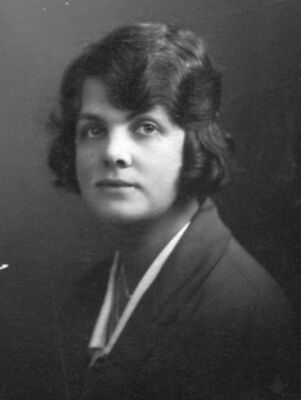Elsie May Jessop (nee Kiddle)
Individual, P147
Biography
Elsie May Jessop (nee Kiddle) (28-8-1901 died at Legana 4-3-1997) was the second child of Frederick Kiddle and Mary Eleanor Kiddle (nee Stones).
Elsie’s parents married at St. John’s shortly before the turn of the 20th century. Her father was a groom in the stables of one of Launceston’s wealthier families, and later curator of the bowls club at Windmill Hill.
In her early and adolescent years, the family at three different homes in the close vicinity of St. George’s Square, East Launceston. Both Elsie and her elder sister Bessie (Eleanor Jane Elizabeth Kiddle), attended Charles St. Practising School until the brand-new (and much closer) East Launceston State School was opened in 1908. Elsie left school at 14 years of age to work at Tabarts Printery in Cimitere St, and spent all her working life in printeries. She was probably in her 70s when she retired.
Her interest in bookbinding led on to her carving. A number of beautiful examples of her carving are still held by family members, and some were featured in an exhibition by the Queen Victoria Museum and Art Gallery in the 1990s. Elsie was strongly influenced by the Arts and Crafts movement of the early 20th century, and made extensive use of native flora in her designs.
Elsie married George William Jessop on 20th December 1935. They had known each other since before WWI, during which George served with the army in France. George was a graphic artist who worked, as Elsie did, in the printing industry. For part of his working life, he was employed by the Alexander Racquet Factory Launceston to paint logos and designs on the products. He is known to have designed at least one Davis Cup of the era.
Elsie and her older sister both attended Sunday School from a young age. Sunday School was quite strict. Examinations were held to measure progress, and the Sunday School hall was set out with tables, under strict supervision. Their younger sister, Mary, once won the Bishop’s Prize, awarded statewide. Sunday School was “school” in the full sense of the word. The next brother, Geoffrey Kiddle, was also active in the Sunday School at the same period. The Sunday School consisted of three divisions, senior, intermediate and kindergarten, which was in the back section of the building. Sybil Brownrigg’s mother took the intermediate section in the middle part of the building. Of course, the kindergarten section had a different program to the older ones! Looking down from the gallery, the Sunday School children could see the beautifully dressed children of the very “well-to-do” families, who would attend church with their parents but were not allowed to attend Sunday School. Sunday School was held twice a day. 60 or more children attended in the afternoon, and about 30 in the mornings. By about 1930, the two sessions were amalgamated into the one morning session.
Elsie became a teacher in the Sunday School, and rose to superintendent of the kindergarten section, and held that position for many years until her marriage in 1935, at which point Miss Kiddle, whom Elsie had recruited as a teacher working with the older boys in the kindergarten, took over the leadership, a post she continued with until the mid 1980s! Sybil Brownrigg, too, was a teacher in the kindergarten section in those early years. The activities included use of sand trays to build up the lessons, singing and other activities. The hour always seemed too short. Geoffrey Kiddle was the secretary and librarian of the Sunday School at the same period. He took his responsibilities very seriously. The Kiddle children were actively encouraged to take on Sunday School responsibilities by their mother, who had a strong sense of duty towards the church.
GFS concerts would be held in the old Mechanics’ Institute (site of the Northern Regional Library), to raise money for the carpet fund and other worthy causes. Mrs. Jessop and Miss Kiddle were members from their teenage years (the joining age was 14), and continued later as Townsend group members. In those days, there was an active connection between GFS as a girls’ organisation at the church, and the GFS hostel which provided for the needs of working girls unable to live at home. In the 1980s, the Townsend group were instrumental in providing for the fine carpet now to be seen in the church. Some older parishioners will recall the fundraising stalls, slide shows, outings and “beetle evenings” of this latter period.
Elsie was a long-time member and supporter of Legacy, who had a holiday shack at Lauderdale available to their members.
Elsie’s life was beset with tragedy. Her husband suffered and died of cancer after 17 years of marriage. Her son Robert was killed in 1960 aged 19 as a result of a motor accident in north Sydney while on military service with the Australian Army Corps of Artillery. Her eldest child, Janet, struggled with mental health issues and died aged 44. Despite these tragic losses, Elsie was an indomitable and cheerful spirit, always a favourite aunt in her wider family, and bringing joy into the lives of those who knew her, alone but never alone for the remaining 17 years of her life.
Elsie was a great admirer of St. John’s wonderful pipe organ, and left a bequest to the church, specifically earmarked for maintenance of the organ. Interest from that bequest still supports maintenance of the organ. In recognition of her work at St. John’s, and her support for the organ, a plaque was erected at the south choir stalls:
IN THANKSGIVING FOR
ELSIE MAY JESSOP
1901-1997
A LOVED PARISHIONER
AND
GENEROUS BENEFACTOR
TO THE ORGAN MAINTENANCE FUND
Source
Abridged version of notes on Mrs. Jessop's life supplied by her relatives in 1997Related object
Memorial Plaque - Elsie May Jessop (Memorial to)Related people
Eleanor Jane Elizabeth Kiddle (sibling of)St. John's Sunday School (connected with)
